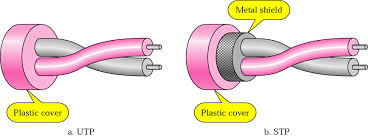In recent years, as the demand for fast-speed and mass media is increasing, optical fiber cable shows an absolute advantage over copper cable. After fiber-to-the-home solved the “last mile problem”, there even emerged a sentence “optic fiber in, and copper wire out” on the Internet. However, is copper cable really useless? The answer is definitely No! Indeed, twisted pair copper cable has many advantages over optical fiber in the application of building wiring.
The most commonly used copper network cable in the horizontal wiring between buildings is twisted pair copper cable. Therefore, in this text, I will illustrate why twisted pair copper cable is a preferred cable in building wiring.
A twisted pair cable is a pair of copper wires, with diameters of 0.4 -0.8mm , twisted together and wrapped with a plastic coating. The twisting increases the electrical noise immunity, and reduces the Bit Error Rate (BER) of the data transmission.
Classified by the inner structure of twisted pair copper cable, it can be divided into Unshielded Twisted Pair (UTP) and Shielded Twisted Pair (STP).
- UTP is just two insulated pair twisted together. The EIA/TIA (Electronic Industry Association/Telecommunication Industry Association) has established standards of UTP and rated 6 categories of wire.
- STP is heavier and more difficult to manufacture, but it can greatly improve the signaling rate in a given transmission scheme. STP is commonly used by large scale companies in high-end applications that require the maximum bandwidth.
The UTP and STP are showed in the picture below.

The difference between UTP and STP are stated below:
- STP cables are shielded while UTP cables are unshielded
- STP cables are more immune to interference and noise than UTP cables
- STP cables are better at maximizing bandwidth compared to UTP cables
- STP cable cost more per meter compared to UTP cables
- STP cables are heavier per meter compared to UTP cables
- UTP cables are more prevalent in SOHO networks while STP is used in more high-end applications.
For most common uses, it does not really matter whether you use STP or UTP as both would probably perform well. UTP is the more logical choice for the majority of enterprises in LAN as it is cheaper and much easier to find.
In the building wiring project, as the physical space of wiring is relevantly spacious, there is no need to worry too much about the wiring density. Therefore, though the diameter of copper wire is larger than optical fiber, there has enough space for the copper wire. And because of the large space, the problem of heat dissipation of copper wires is solved. The distance between enterprise buildings is relevantly short, therefore, even though the attenuation of copper wires is bigger than optical fibers, the influence on the whole network is small. What’s more, the port energy consumption has lower degree of influence on building wiring compared with data center. Therefore, the factors to be considered in the building wiring system inclined to the total cost of the project.
Compared with fiber optic network device, copper cable network device has an obvious advantage over the cost. Therefore, the copper twisted pair wiring system will remain the first choice in a fairly long period of time.
Besides the easy implementation and lower cost, twisted pair copper cable has other strengths:
- High utilization of cables.
If a portion of a twisted pair cable is damaged, it does not affect the entire network. - Anti-interference.
Twisted pair cable can effectively restrain common mode interference. Even under the strong interference environment, it can transmit very strong image signals. - High reliability.
One of the biggest advantages of copper cable is reliability. Network reliability is usually measured by Bit Error Rate (BER). The BER of copper cable is usually lower than the industry standard.
When choosing UTPs, you should remind that the tighter the twisting, the higher the supported transmission rate and the greater the cost per foot. More twists per inch means more linear feet of copper wire used to make up a cable run, and more copper means more money.
If you are considering to rewire your buildings, the twisted pair copper cable is a good choice for your short distance cable application.
Fiberstore is a professional manufacturer specializes in producing telecommunication products. It always assures with masterly technology, excellent service and good reputation that won broad user reputably.
Related Article:
Twisted-Pair Cable Plant Components
Twisted Pair Cable Is Perfect For Short Distance Transmission
